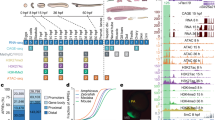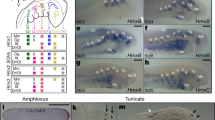Abstract
High mobility group A proteins of vertebrates, HMGA1 and 2, are chromatin architectural factors involved in development, cell differentiation, and neoplastic transformation. Here, we characterize an amphioxus HMGA gene ortholog and analyze its expression. As a basal chordate, amphioxus is well placed to provide insights into the evolution of the HMGA gene family, particularly in the transition from invertebrates to vertebrates. Our phylogenetic analysis supports the basal position of amphioxus, echinoderm, and hemichordate HMGA sequences to those of vertebrate HMGA1 and HMGA2. Consistent with this, the genomic landscape around amphioxus HMGA shares features with both. Whole mount in situ hybridization shows that amphioxus HMGA mRNA is detectable from neurula stage onwards in both nervous and non-nervous tissues. This correlates with protein expression monitored immunocytochemically using antibodies against human HMGA2 protein, revealing especially high levels of expression in cells of the lamellar body, the amphioxus homolog of the pineal, suggesting that the gene may have, among its many functions, an evolutionarily conserved role in photoreceptor differentiation.






Similar content being viewed by others
References
Benini F, Onorati M, Altamura S, Manfioletti G, Vignali R (2006) Identification and developmental expression of Xenopus hmga2βeta. Biochem Biophys Res Commun 351:392–397
Bianchi ME, Agresti A (2005) HMG proteins: dynamic players in gene regulation and differentiation. Curr Opin Genet Dev 15:496–506
Candiani S, Garbarino G, Pestarino M (2015) Detection of mRNA and microRNA expression in basal chordates, amphioxus and ascidians. NeuroMethods 99:279–292
Chau KY, Munshi N, Keane-Myers A, Cheung-Chau KW, Tai AK, Manfioletti G, Dorey CK, Thanos D, Zack DJ, Ono SJ (2000) The architectural transcription factor high mobility group I(Y) participates in photoreceptor-specific gene expression. J Neurosci 20:7317–7324
Chiappetta G, Avantaggiato V, Visconti R, Fedele M, Battista S, Trapasso F, Merciai BM, Fidanza V, Giancotti V, Santoro M, Simeone A, Fusco A (1996) High level expression of the HMGI (Y) gene during embryonic development. Oncogene 13:2439–2446
Fedele M, Fusco A (2010) Role of the high mobility group a proteins in the regulation of pituitary cell cycle. J Mol Endocrinol 44:309–318
Fedele M, Fidanza V, Battista S, Pentimalli F, Klein-Szanto AJ, Visone R, De Martino I, Curcio A, Morisco C, Del Vecchio L, Baldassarre G, Arra C, Viglietto G, Indolfi C, Croce CM, Fusco A (2006) Haploinsufficiency of the Hmga1 gene causes cardiac hypertrophy and myelo-lymphoproliferative disorders in mice. Cancer Res 66:2536–2543
Foti D, Chiefari E, Fedele M, Iuliano R, Brunetti L, Paonessa F, Manfioletti G, Barbetti F, Brunetti A, Croce CM, Fusco A, Brunetti A (2005) Lack of the architectural factor HMGA1 causes insulin resistance and diabetes in humans and mice. Nat Med 11:765–773
Fuentes M, Benito E, Bertrand S, Paris M, Mignardot A, Godoy L, Jimenez-Delgado S, Oliveri D, Candiani S, Hirsinger E, D'Aniello S, Pascual-Anaya J, Maeso I, Pestarino M, Vernier P, Nicolas JF, Schubert M, Laudet V, Geneviere AM, Albalat R, Garcia Fernandez J, Holland ND, Escriva H (2007) Insights into spawning behavior and development of the European amphioxus (Branchiostoma lanceolatum). J Exp Zool Part B: Mol Dev Evol 308:484–493
Grasser KD (2003) Chromatin-associated HMGA and HMGB proteins: versatile co-regulators of DNA-dependent processes. Plant Mol Biol 53:281–295
Hecht J, Stricker S, Wiecha U, Stiege A, Panapoulou G, Podsialowski L, Poustka AJ, Dieterich C, Ehrich S, Suvorova J, Mundlos S, Seitz V (2008) Evolution of a core gene network for skeletogenesis in chordates. PLoS Genet 4:e1000025
Hock R, Witte F, Brocher J, Schutz M, Scheer U (2006) Expression of HMGA2 variants during oogenesis and early embryogenesis of Xenopus laevis. Eur J Cell Biol 85:519–528
Holland LZ, Holland PWH, Holland ND, Ferraris JD, Palumbi SR (1996) Revealing homologies between body parts of distantly related animals by in situ hybridization to developmental genes: amphioxus versus vertebrates. In: Ferraris JD, Palumbi SR (eds) Molecular zoology: advances, strategies, and protocols, vol 267. Wiley Press, New York, pp 473–483
Holland LZ, Albalat R, Azumi K, Benito-Gutiérrez E, Blow MJ, Bronner-Fraser M, Brunet F, Butts T et al (2008) The amphioxus genome illuminates vertebrate origins and cephalochordate biology. Genome Res 18:1100–1111
Jandzik D, Garnett AT, Square TA, Cattell MV, Yu J-K, Medeiros DM (2015) Evolution of the new vertebrate head by co-option of an ancient chordate skeletal tissue. Nature 518:534–537
Lacalli TC (2008) Basic features of the ancestral chordate brain: a protochordate perspective. Brain Res Bull 75:319–323
Lacalli TC, Holland ND, West JE (1994) Landmarks in the anterior central nervous system of amphioxus larvae. Phil Trans R Soc B344:165–185
Macrì S, Simula L, Pellarin I, Pegoraro S, Onorati M, Sgarra R, Manfioletti G, Vignali R (2016) Hmga2 is required for neural crest cell specification in Xenopus laevis. Dev Biol 411:25–37
Monzen K, Ito Y, Naito AT, Kasai H, Hiroi Y, Hayashi D, Shiojima I, Yamazaki T, Miyazono K, Asashima M, Nagai R, Komuro I (2008) A crucial role of a high mobility group protein HMGA2 in cardiogenesis. Nat Cell Biol 10:567–574
Moussavi Nik SH, Newman M, Lardelli M (2011) The response of HMGA1 to changes in oxygen availability is evolutionarily conserved. Exp Cell Res 317:1503–1512
Nishino J, Kim I, Chada K, Morrison SJ (2008) Hmga2 promotes neural stem cell self-renewal in young but not old mice by reducing p16Ink4a and p19Arf expression. Cell 135:227–239
Pegoraro S, Ros G, Piazza S, Sommaggio R, Ciani Y, Rosato A, Sgarra R, Del Sal G, Manfioletti G (2013) HMGA1 promotes metastatic processes in basal-like breast cancer regulating EMT and stemness. Oncotarget 4:1293–1308
Reeves R (2001) Molecular biology of HMGA proteins: hubs of nuclear function. Gene 277:63–81
Reeves R (2010) Nuclear functions of the HMG proteins. Biochim Biophys Acta 1799:3–14
Ruiz S, Anadón R (1991) The fine structure of lamellate cells in the brain of amphioxus (Branchiostoma lanceolatum, Cephalochordata). Cell Tissue Res 263:597–600
Rychel AL, Swalla BJ (2007) Development and evolution of chordate cartilage. J Exp Zool (Mol Dev Evol) 308B:325–335
Sgarra R, Rustighi A, Tessari MA, Di Bernardo J, Altamura S, Fusco A, Manfioletti G, Giancotti V (2004) Nuclear phosphoproteins HMGA and their relationship with chromatin structure and cancer. FEBS Lett 574:1–8
Sgarra R, Zammitti S, Lo Sardo A, Maurizio E, Arnoldo L, Pegoraro S, Giancotti V, Manfioletti G (2010) HMGA molecular network: from transcriptional regulation to chromatin remodeling. Biochim Biophys Acta 1799:37–47
Somorjai I, Bertrand S, Camasses A, Haguenauer A, Escriva H (2008) Evidence for stasis and not genetic piracy in developmental expression patterns of Branchiostoma lanceolatum and Branchiostoma floridae, two amphioxus species that have evolved independently over the course of 200 Myr. Dev Genes Evol 218:703–713
Tamura K, Stecher G, Peterson D, Filipski A, Kumar S (2013) MEGA6: molecular evolutionary genetics analysis version 6.0. Mol Biol Evol 30:2725–2729
Wicht H, Lacalli TC (2005) The nervous system of amphioxus: structure, development, and evolutionary significance. Can J Zool 83:122–150
Yie J, Merika M, Munshi N, Chen G, Thanos D (1999) The role of HMG I(Y) in the assembly and function of the IFN-beta enhanceosome. EMBO J 18:3074–3089
Yong LW, Yu J-K (2016) Tracing the evolutionary origin of vertebrate skeletal tissues: insights from cephalochordate amphioxus. Curr Opin Genet Dev 39:55–62
Zhou X, Benson KF, Ashar HR, Chada K (1995) Mutation responsible for the mouse pygmy phenotype in the developmentally regulated factor HMGI-C. Nature 376:771–774
Acknowledgements
We thank Skip Pierce and John M. Lawrence (Biology Department, USF, Tampa, FL) for providing lab space and equipment, Ray Martinez and Marilyn Wetzel (Department of Biology, USF, Tampa, FL) for logistic support, Linda Holland (Scripps Institute, La Jolla, CA) and Héctor Escriva and colleagues (CNRS, Unité Mixte de Recherche 7232, Université Pierre et Marie Curie Paris 06 and the Observatoire Océanologique, Banyuls-sur-Mèr) for their help obtaining B. floridae and B. lanceolatum adults and embryos, and for providing lab space and technical assistance. We also thank Lorenzo Zambini for sharing unpublished data, Heather Down for assistance preparing Fig. 6a, and two reviewers for their detailed critique of the manuscript. This work was supported by a University of Genoa National Grant and ASSEMBLE grant no.227799 to SC and MP, MIUR grant 2009XW7XSX to RV and GM, and funding from the Lionel G. Harrison Research Trust to TL.
Author information
Authors and Affiliations
Corresponding author
Ethics declarations
Conflict of interest
The authors have no conflict of interest.
Additional information
Communicated by Karen E Sears
Electronic supplementary material
Supplementary file 1
List of the sequences used in the phylogenetic analysis. (DOCX 80 kb).
Supplementary file 2
HMGA expression in B. lanceolatum neurulae and larvae. A: Side view of a mid-neurula. B: Side view of a 24-h late neurula. C,D: Side views of a 36-h and 1-gill slit larvae. po, preoral pit; lmb, lamellar body. Scale bars: 50 μm. (GIF 228 kb).
Rights and permissions
About this article
Cite this article
Bozzo, M., Macrì, S., Calzia, D. et al. The HMGA gene family in chordates: evolutionary perspectives from amphioxus. Dev Genes Evol 227, 201–211 (2017). https://doi.org/10.1007/s00427-017-0581-8
Received:
Accepted:
Published:
Issue Date:
DOI: https://doi.org/10.1007/s00427-017-0581-8




